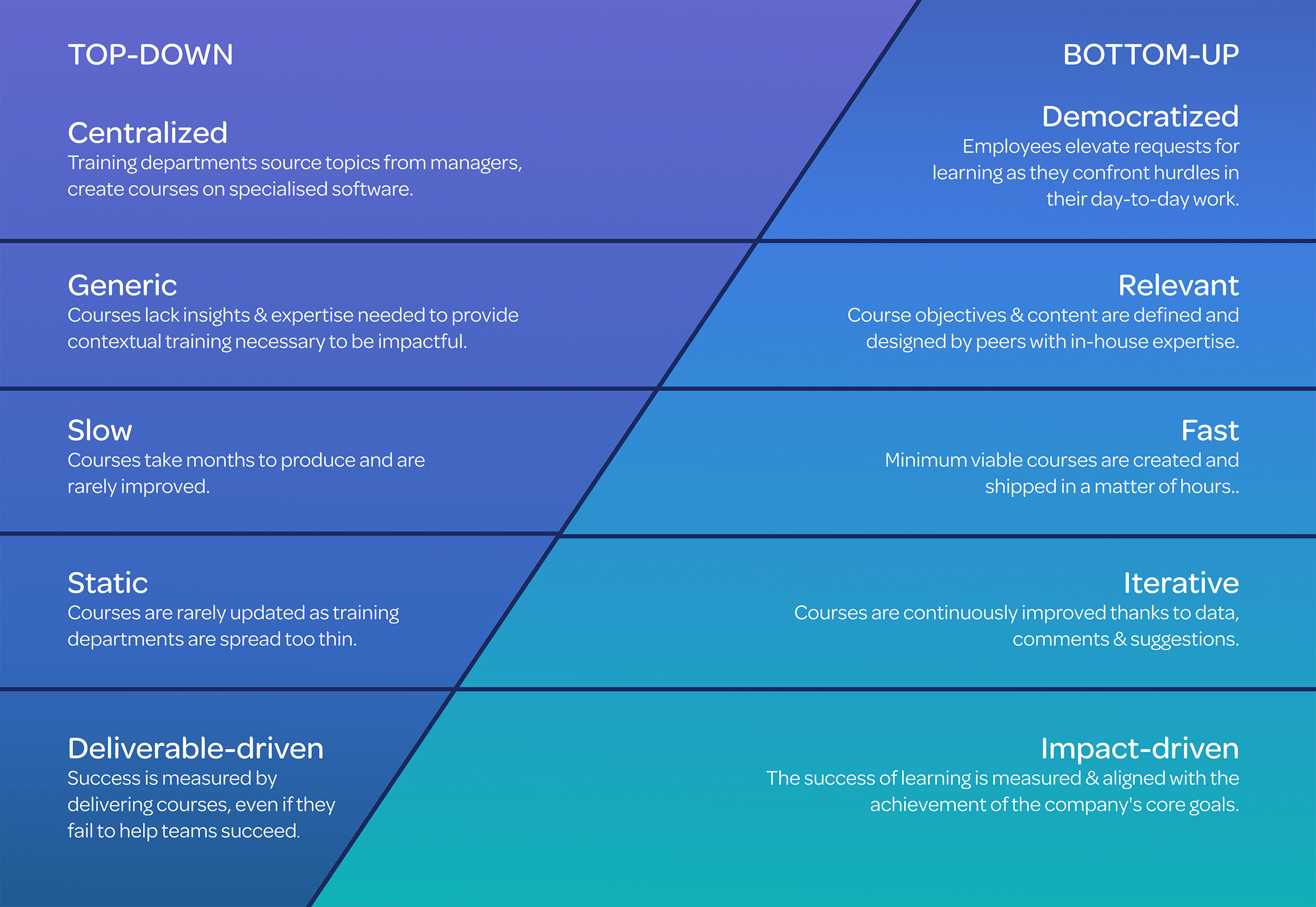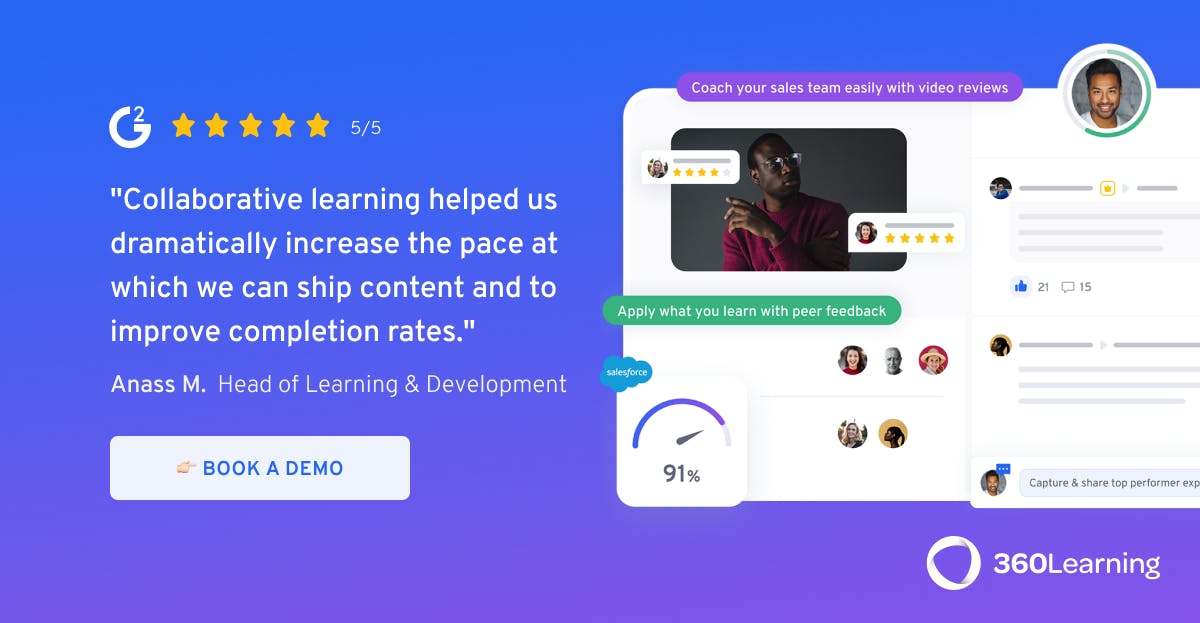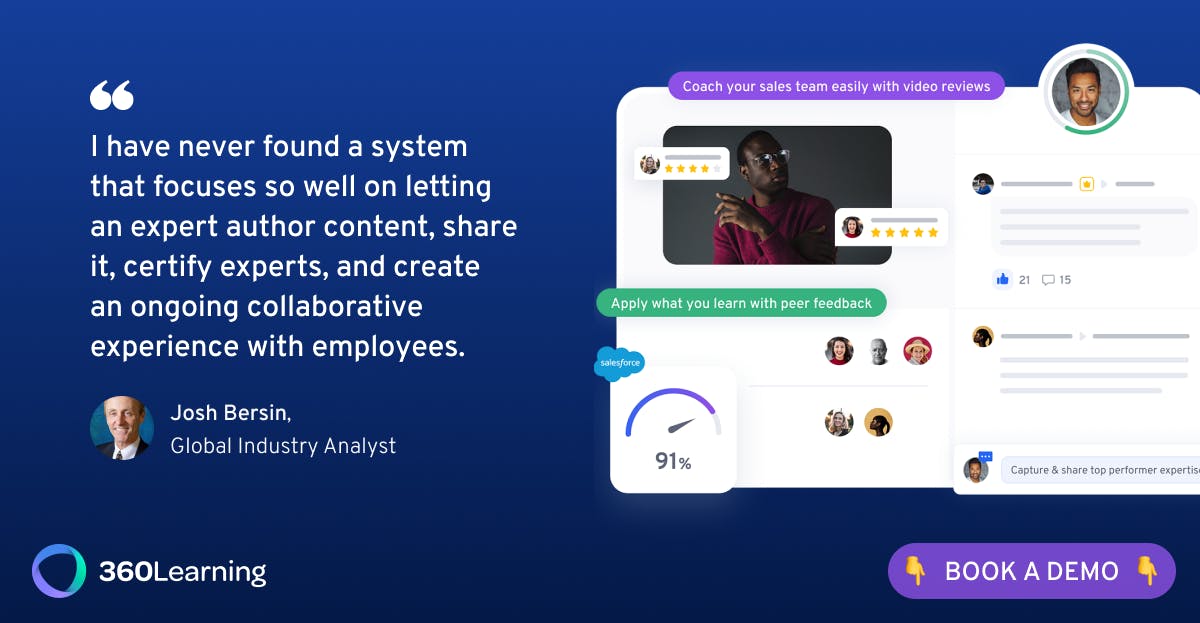COVID-19 has shifted the work-from-home norms, and possibly for good. According to a PwC survey from January 2021, 83% of employers and 71% of employees consider the switch to remover work during COVID-19 to have been a success.
Now that teams are no longer face-to-face in the office, we can’t count on compulsory attendance or looking over someone’s screen to check if they’re completing their training courses.
One way to ensure your teams are learning from afar? Create an effective Collaborative Learning environment, where learners are self-driven and motivated to engage and complete your collaborative learning activities—or even contribute by creating their own. Sound too good to be true? All you need is the right mindset and tools.
4 ways to make your workplace a Collaborative Learning environment
Here are the four essential elements to creating an effective Collaborative Learning environment. If you can get these details right, you’ll support every one of your teams to be self-motivated and engaged in autonomous learning.
1. Embrace decentralized learning
Centralized learning flows a single point: trainers teach and employees learn in group instruction. But many businesses are shifting towards a more decentralized approach, making this system obsolete. More employees are working remotely and asynchronously, and they need to break learning into small chunks that fit into their daily work schedule.
The first step in decentralizing learning is to use technology and shift to online classes that can be completed in micro-sessions throughout the week.
But decentralized learning goes farther than that. In a decentralized, Collaborative Learning environment, each team member participates in the learning process. They can identify their learning needs and the learning strategies that work for them, request courses, give feedback on existing courses, and create courses themselves. We call this a bottom-up approach.
Related: Centralized vs. Decentralized - Which is the Right L&D Approach for Your Business?
In traditional learning, executives or a company’s Learning and Development department will make educated guesses about employees’ knowledge gaps and either create or outsource courses to correct those gaps. Courses are expensive to produce and can take months to create. Knowledge flows downward without enough input from the people receiving it.
With a bottom-up approach, employees use a Collaborative Learning platform to make requests for learning opportunities. Everyone can vote on which courses would be most useful, and anyone can offer to teach a course. Courses can be created and updated much more quickly, which helps the company keep its workforce up-to-date on important skills.
Here’s how bottom-up learning works:

Decentralized learning democratizes knowledge, letting everyone share the benefits of information. Perhaps, most importantly, decentralized learning is more agile and adaptable than old-school, centralized learning systems.
According to our research, among companies that use 360Learning, non-trainers create 85% of the courses. When the process is democratized, everyone is accountable for their own learning and empowered to take control of their goals.
2. Emphasize self-directed learning
No one knows their own learning needs like your employees do. When you enable self-directed learning, you're fostering your employees’ growth and also maximizing the benefits for your company.
Self-directed learning gives your team the most autonomy and flexibility: they can complete courses on their own schedule and work toward their targets independently. They can fit courses around other work because they’re empowered to manage their own learning activities.
Despite the name, self-directed learning involves teamwork. For self-directed learning to be effective, the entire company needs to be on board. Team managers and L&D engage in collaborative work to act as facilitators that help set learning targets, suggest courses, facilitate the flow of learning content, and create a schedule. Employees identify their own learning needs, and executives promote cooperative learning within the company and also lead by example by sharing information on their own goals.
This independent learning approach aligns with what learners themselves want: according to LinkedIn’s 2019 Workplace Learning Report, 43% of Gen Z learners and 42% of Millennial learners want decision-making freedom to take courses at their own pace. At the same time, 75% say they would take a course their manager recommended.
3. Promote knowledge sharing
When you hire a talented team, your employees are your greatest resource. They have the skills, the smarts, and the expertise to help your company succeed—after all, that’s why you hired them. By promoting knowledge sharing within your company, you tap into the power of cooperative learning.
Old-school, top-down learning runs the risk of creating information silos. In this scenario, sales teams are only told about sales goals, and marketing departments lack insight into product development.
In a Collaborative Learning environment, employees can help each other better understand their work and gain valuable visibility into other departments, which helps them stay aligned on global strategy and promotes critical thinking across teams, even when working remotely. This team interdependence and group work translate to employees becoming more invested in the company as a whole, and being part of a learning community and sharing knowledge lead to higher employee satisfaction.
Another valuable benefit of promoting knowledge sharing within your company is to reduce the risk of brain drain. In a top-down environment, employees amass institutional knowledge—a client’s likes and dislikes, the specifics of a technical process—and use that knowledge to do their jobs well. But when they leave, all that valuable information goes with them. When a company promotes knowledge sharing, institutional information can be shared and accessed, even after an employee moves on.
4. Choose the right Collaborative Learning platform
To create an effective Collaborative Learning environment, your most important tool is the right Collaborative Learning platform. Collaborative Learning platforms like 360Learning allow companies to easily and inexpensively create courses targeted to their employees’ needs.
Collaborative Learning platforms offer several key advantages over traditional Learning Management Platforms and Learning Experience Platforms. For one, they make it faster, easier, and cheaper to create courses, since courses are created by employees as needs arise.
L&D departments no longer need to spend time building and sourcing learning content—tasks that take up 29% of an L&D team’s time. Instead, they become learning facilitators and have more time to meet with key stakeholders, facilitate the flow of learning content, and strategize.
Because courses on a Collaborative Learning platform are created internally, they are specific to your company’s needs and targeted to your team, meaning no more generic, one-size-fits-all lessons. Any skills gaps in the company can be addressed immediately, and outdated courses can quickly be flagged and corrected. This helps your company stay competitive and responsive to rapid market changes.
Finally, using a Collaborative Learning platform puts the focus on ROI. Traditionally, the success of a company’s learning initiative is measured by course completions or minutes of learning per month. This gives a good idea of how much coursework is being completed, but it doesn’t tell us how the learning is actually benefiting the company. Collaborative Learning platforms are tailored to your company’s own needs and skills gaps. As team members progress, you can measure improvements in their outcomes and gauge the overall student success for each learning initiative.
Creating an effective Collaborative Learning environment takes work
Creating an effective Collaborative Learning environment requires moving away from an instructor-led, top-down teaching strategy. And like any sustainable learning ecosystem, it takes effort and problem-solving to put into practice.
But research shows that making the shift could lead to more learning in the long run. According to LinkedIn’s 2020 Workplace Learning Report, 67% of Gen Z and 50% of millennials feel motivated to learn in a social environment. That’s why creating a collaborative classroom environment is so critical to employee engagement and satisfaction.
If you’re interested to learn more or need help creating a Collaborative Learning environment at your workplace, get in touch!




